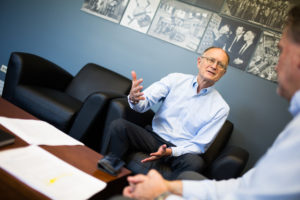
We’re emerging from a global pandemic. Americans’ perspectives on how and where people work are fundamentally changing. Policymakers in Washington are deliberating about clean energy and climate initiatives that may refocus the research priorities at the DOE national laboratories.
Lab Director Mike Witherell offered his thoughts recently on the Lab’s directions and most urgent challenges. Chief Communications Officer John German conducted the interview.
John German: Thank you for taking the time to share your thoughts. It’s a busy time. Let’s start with our science. The Lab’s research mission seems very well matched with the emerging national priorities right now. What is the state of the Lab’s science mission today?
Mike Witherell: I think we are doing very well right now. Every year we deliver our Annual Lab Plan to the Department of Energy. Again this year, the feedback we received from our program offices was very positive. I think we’re well aligned with what they want to do. This year in particular they gave us a lot of credit for our strategic use of LDRD [Laboratory Directed Research and Development, or discretionary funding] to start up new lines of research. That was very encouraging.
At the same time, the Biden Administration has introduced these clean energy technology programs called Earthshots, which are chances for the federal government to make big bets on efforts to address climate change. If you look at the ideas they’re proposing for possible Earthshots, they align very well with research priorities we’ve been working on for years. So we’re very excited about that. Two of these Earthshots have already rolled out. One is on clean hydrogen and how to produce, store, and use hydrogen in a carbon-neutral way. The second concerns long-term energy storage and grid-scale energy storage. We’re expecting more Earthshots on topics like carbon capture and reuse, alternative fuels, energy and water, decarbonizing industry, and transportation. They’ll probably roll out three or four more next year. We’re excited about these because we think we’ll have significant contributions to make on all of them.
German: What are some of the Lab’s biggest research highlights from the last year, and what are some of our biggest opportunities?
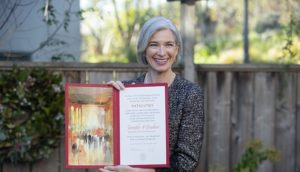
Witherell: In terms of highlights, it’s hard to beat having a Nobel Prize awarded to someone who’s working in your institution. I’ve had that experience a few times in my career, and it is always a treat. It was great that Jennifer Doudna won the Nobel Prize in chemistry last year for the discovery of CRISPR, and to have the chance to note the big role our LDRD investments played in getting that going, as well as her long-term and continuing research using the structural biology beamlines at the Advanced Light Source.
Another highlight and opportunity is the growing role that computing and data science are playing in advancing research across the Laboratory. Partly in recognition of that, our Computing Research Division split into two parts recently; now there’s fundamental computer science in the Computational Research Division and the more outward-looking, data science and applications-focused Scientific Data Division, the new division led by Deb Agarwal. I think this restructure really helps us take advantage of some of the biggest opportunities in science, which is awash in data and can’t really progress without new solutions to both managing data and figuring out which data might be important.
I already talked about our deep capabilities in addressing the Earthshots. Clean energy, the environment, a circular water economy, biomanufacturing, aviation fuels, and critical materials are all areas that we’ve had programs going on, and I think they can really mature now with this emphasis from the Administration.
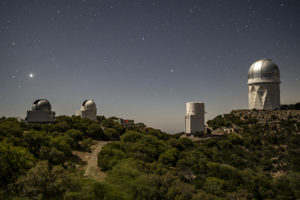
Then there’s physics, my first love, where we have a lot going on. The DESI [Dark Energy Spectroscopic Instrument] Project is, of course, now starting its survey from the telescope in Arizona, and the first results just look fantastic. It’s really going to be transformative work. My own home favorite is our LZ [LUX-ZEPLIN] dark matter experiment in South Dakota, which I had a small part in helping design and get started. LZ is starting to take data, and I’m excited with my colleagues to see what we’re going to find there. Our next big thing, of course, is the Cosmic Microwave Background program [CMB-S4]. That’s a large national program to build millimeter-wave telescopes located in Chile and Antarctica. That’s a long-term bet and we’re going to be doing that for years to come.
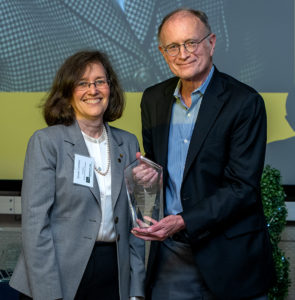
There’s so much more going on around the Lab. One of the most enjoyable and rewarding days of the year at the laboratory, for me, is the Director’s Achievement Awards. The best part for me is when I get to call up people and tell them they’re getting an award. Then the ceremony itself…it’s a really wonderful event in person, but it’s still pretty special in a virtual environment. We’re doing that again on November 18 at noon. The nice thing about the virtual awards is everybody can come; we don’t have to limit it to the size of the auditorium. So this is a chance for people to see what great things their colleagues are accomplishing.
German: What are you hearing about how the FY22 budget cycle is shaping up for science, for DOE, and for Berkeley Lab?
Witherell: I just saw the information from the Lab’s fiscal close for FY21. We again achieved our record level of effort. The laboratory did $1.06 billion of work in FY21, and that’s about a 5% increase over the previous year. So that’s remarkable, especially when you consider that it occurred while we were adapting to the realities of the pandemic. In FY22, most of the Laboratory, the major part that is funded by the Office of Science, it’s going to be pretty much steady as she goes. The projects that are going on will keep going on schedule. The possible big changes will be in clean energy technologies, and this should be better than steady. Construction projects are going on, as well, and we have quite a few either just started or poised to start. Laboratory renewal has been an important and critical need for us. So we could see an acceleration in our construction projects.
German: What about the confusing deliberations around the continuing resolution and debt ceiling?
Witherell: We have our yearly cycle with the continuing resolution, and that’s going in the usual way. We’ve operated temporarily under a CR more often than not over the past several years. Usually, they find a way of getting the budget passed, but if they don’t, we keep going anyway. A CR typically has very little impact on the Lab. The new uncertainty is the federal debt limit or the debt ceiling. Reaching the debt ceiling isn’t something that has happened before. Frankly, if we do get close to that, it will cause a much bigger impact than a CR. If the government ever reached the debt ceiling, it wouldn’t be authorized to pay its bills at all, and that would be a huge problem, not just for the Lab but the nation’s economy. No one wants the government to default on its financial obligations, so we’re hoping that Congress will see that and keep us from getting too close. I think the high consequences of it happening means its likelihood of happening is very low. But we’ll be watching that situation very closely as we approach December 3, the new deadline Congress has set to resolve the problem.
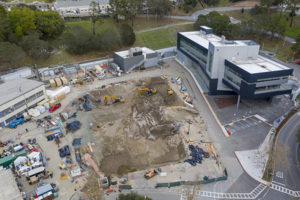
German: What many people might not realize, if they haven’t been on site, is that there is quite a bit of construction going on right now, with more planned. How is the Lab preparing for the future of science?
Witherell: First of all, every day as I’m sitting here, I’m hearing all the trucks outside my office. For people who haven’t been onsite recently, the level of construction is really remarkable. At the BioEPIC site, we’ve completed clean-up and utility work in preparation for facility construction, so if you look next to the Integrative Genomics Building, you’ll see the construction of the BioEPIC building beginning. We had a small groundbreaking ceremony to mark this recently, and that was satisfying. The ALS-U [Advanced Light Source Upgrade] project keeps progressing. That’s our biggest project. NERSC-9 is well along; new science is already being done with the new computer, Perlmutter. And we just got approval for the mission need for the next big NERSC upgrade, NERSC-10. ESnet is making great progress and finishing up its upgrade. At the Grizzly Substation Yard, the Lab recently completed the demolition of Building 79, which was rated seismically poor and was located adjacent to the existing electrical distribution yard. The existing yard will be expanded in preparation for an electrical distribution expansion, which will occur in the coming years as part of LAMP [Linear Asset Modernization Project]. The new electrical capability is critical to the reliable operation of the Lab, with particular emphasis on expanded power delivery to the new NERSC-10 computer. Over in the Old Town area, near the ALS, they are finishing up cleanup work, getting that site ready for new facilities. The building that houses the cafeteria is closing and we’re getting ready to begin demolition and start to build a new Welcome Center and cafeteria for the Lab, which will be a focal point for our community. So major projects are going on all over the Lab. It’s important to note that we are going to be doing smaller upgrades, renewing some of the places on our main site that have not been up to the standards we need for safe laboratory space. We’re going to be putting a lot of attention on small infrastructure renewal, as well, things like pipes and electrical service. We are preparing for the future, and this will be looked back on as an era of renewing the Laboratory, I think, 10 years from now. That’s the time it will take to get a lot of this work done.
German: The Lab is operating very differently from what used to be the norm for most people on our sites every day. What lessons has the pandemic brought us, and how might our recent experiences change how the Lab operates in the future?
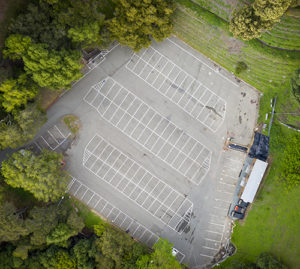
Witherell: Suddenly in March of 2020, we had to shift to this new mode of work and then figure out what we could do to bring a limited number of people back and how we could continue to achieve our mission with most of our people working away from our sites. The big discovery was how many things we could do very well in this mode, once we turned our attention to it. What I learned and what I think people all over the country have been learning is that we had some perceptions about working onsite versus telework that was probably 20 years out of date. We learned that we actually have tools that allow us to bring people together in new ways, and so we set out to figure out how to use them effectively, and we did. It also turns out that a lot of our people were doing very long commutes every day, and this gave us a chance to think about, if they’re only commuting three days a week instead of five days a week, then that time is going to be spent doing something else; instead of spending it in a car people can spend it on both their work and on their personal lives in ways that are more productive, for example. It pushed us in the direction of thinking about how we could approach work differently.
So we put a very talented team together a few months ago to think about the long-term future of work. The other thing we’ve learned from the pandemic is how, before you try new things, you need to have a lot of conversations. You can’t find a group of experts who know everything we should do. So we’ve been developing these new policies and processes adapted to our environment, trying them out with the areas and divisions, and having them come back to tell us what they learned. This has been a really positive effort and a lot of people have been involved in these discussions. I think it is going to be something that improves the quality of work and the quality of life at the laboratory in the long run.
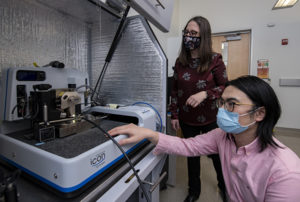
At the same time, change is difficult. It does make people worry. The thing that I worry about is that we have a successful team science approach here and a way of working together. When it works well, it is really the secret sauce in how we get things done. How can we sustain the best parts of that approach while affording individuals the extra flexibility to organize their work lives and their personal lives? It’s an important thing to get right. And we’re going to be working very hard to get it right. We will have to learn how to do this as we go. We’re not finished learning and adapting to this new scenario.
German: When does this new way of working begin?
Witherell: A year and a half ago the discussion was when is this going to be over? When are we able to return? We talked about being ready to do it early in FY21, and when that time came and went it was very discouraging to people. I think we now have a different picture. It’s not when the pandemic is suddenly over. We are just at the start of what will be an extended transition from the pandemic era to the endemic era. The endemic era is when, as a society, we are living with the fact that we have this virus around, and we are able to live with it in a way that keeps us safe. I think people are realizing that’s the transition we are realistically facing, here and elsewhere. It’s going to be a steady transition to what is going to be our future of work mode. So if you say, when is that transition happening? It’s already starting. We have more people on site today than a few months ago. This is the beginning of that transition. We’ll get to a point and look back and say, well that transition is over, we’ve completed it. It’s not going to happen all in one day.
German: Did you ever expect to be leading a national lab on Zoom?
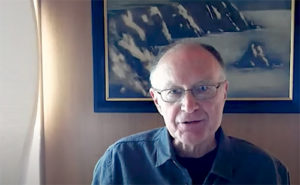
Witherell: No. I never expected to lead a national lab at all, in fact. But I’ve gotten over that. Every once in a while I’m sitting in this corner of my living room waiting for my next meeting thinking about how the Lab is doing and how we’re doing. And I say “gosh, this is really not what I thought it would be like being a lab director.” It makes explicit how much a lab director depends on having great people around them doing all their jobs. You can’t pretend to be doing everything yourself when you’re there in that living room, working on Zoom. I think it makes explicit what we know, which is that a lab works to the extent that it has distributed leadership all over the laboratory that all are doing a great job. That’s really what it takes.
German: Recently you announced some revised stewardship values for the Lab — Team Science, Innovation, Service, Trust, and Respect. How do the values, plus the concepts of stewardship and the principles of IDEA, guide us?
Witherell: A few years ago, I started thinking about how you communicate to over 7,000 people in the Laboratory community about the ideals that hold us together. And that was really where the stewardship discussion started. Stewardship is about taking care of the Lab’s people, research, and resources so we can continue to be a great laboratory. It’s something that everybody was vaguely aware of, but it was never made explicit. So I was just bringing those discussions to the forefront. Fortunately, we made progress on those discussions before the pandemic hit. If we hadn’t had this shared way of communicating across the Laboratory in place when the pandemic hit, we would not have done as well as we’ve done. Taking care of each other and the Lab definitely became an urgent priority as soon as we realized that keeping ourselves safe and healthy with COVID-19 in our environment depended on everyone working together. That was the basis of our COVID protocols and our Health Pledge.
I think now our focus can be how do we take what we’ve learned and keep them for the longer term. That’s what led us to these five stewardship values, which really were already here in practice at the Lab and we just made them explicit. I’m very pleased with Team Science, Innovation, Service, Trust, and Respect. These are values we already aspire to and everybody here is already trying to do. And so I’d like to have people feel that if they want to be in the center of this discussion, they have an opportunity to do that. Our next stage will be a Stewardship Town Hall, which we are now planning for early January. But we can practice them now. They should guide our behaviors.

You also asked about inclusion, diversity, equity, and accountability, what we call IDEA. IDEA is part of how we take care of one another. It’s not a separate thing we do from our research roles or from our operations roles. Once again, our discussions and efforts to embed IDEA into our culture prior to 2020 enabled us, in many ways, to respond to the demands of the national and global moment when the pandemic hit. The impact of the pandemic was very personal and differentiated for each employee in our workforce, depending on their circumstances, identities, and backgrounds. Our surveys told us that people were feeling new and exacerbated pressures and that our working parents in particular were going to need additional support and flexibility. We also saw clearly that there was a much greater need to increase access to mental health resources, to expand and empower our employee resources groups [ERGs] to create support networks for communities disproportionately affected by the pandemic, and to address the isolation that many employees felt as they transitioned to virtual spaces after working and interacting with each other at the Lab for so long. I’m pleased that some of these local efforts, particularly those around implementing more inclusive policies, have matured to a point where the other national lab directors have followed suit. For instance, we asked our Laboratory Operations Board to take some proposals to DOE for a set of family-friendly policy changes at all the national labs. We’re also joining with the University of California’s policies on family leave. So I’m really pleased that our commitment to taking care of people at a principles level is transforming into formal ways of taking care of people at a policy level. We can always do better on both fronts, and we will continue to deepen and operationalize our IDEA principles as we emerge from the pandemic.
I also want to acknowledge the benefits of the initiative to help transgender scientists change their names on their past research. It’s something we started here at the Lab and then it really caught a lot of attention and currency around the country. All 17 of the national labs stepped up, and then most of the academic publishing houses did too. This has brought permanent change to the experience of transgender researchers in publishing. I’m proud that our Lab is leading this.
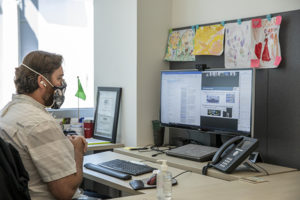
German: What do you expect to be the greatest cultural challenge in the coming year as we learn to work together in new ways?
Witherell: Managing the development of a flexible work environment and the acceptance of that environment by our community will be our prime, overarching goal for the next year. That’s what we all have to do together. It’s important that everyone’s involved in creating this new environment. We don’t know enough to say exactly what it will be like. We’ll do the best we can to get it started. Then we’ll need to be a learning organization that figures this out as we go, and we need to have everybody take responsibility for making it work well. That’s at the heart of those stewardship values, the idea that everybody feels responsible for trying to make it work. One thing each of us can do to advance inclusion is to make sure everybody at the Lab has a chance to contribute, no matter where they are working from.
German: What are some things you’re looking forward to in the next year?
Witherell: What I’m excited about today, and what I hope everybody’s looking forward to doing more of, is coming into work and seeing people I haven’t seen for a year or two. My last meeting was with Carol Burns, our Deputy Lab Director for Research. She is replacing Horst Simon, who was such a great contributor to this laboratory for so long. Carol brings a perspective from another national lab where they’ve been dealing with the same issues we are: about how to get people to work together and how to adopt a shared perspective on the Lab’s priorities. As I go down the hall I see Therese Leone, who’s our new Chief Laboratory Counsel, which is a very important role at the Lab. She brings me advice about how we should manage in this complex environment. We just had our retreat with the Associate Lab Directors to actually think about our shared priorities and challenges, and that was an exciting and collaborative discussion. Down the hall, we have our K-12 Programs that Faith Dukes is leading. We’re doing quite a bit more with our local schools, as a way of connecting with our local community, than we’ve done before. I think we’re seeing more steady support for these sorts of educational programs from Washington. I think this is a real opportunity for us. These programs run on volunteer support. So many of the volunteers are scientists who want to be involved in reaching these kids about STEM education, and I want to thank everybody who volunteers to make these programs possible. It’s really important for us and for the community. And so for me, having people back at the Lab, talking together, walking into offices, that’s really exciting and what I’m looking forward to.
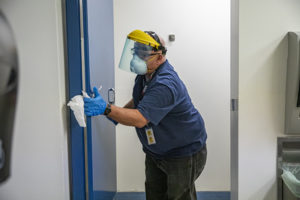
German: Anything else you’d like to say?
Witherell: I want to take the opportunity to say how proud I am to be the lab director here and to thank the people for making this a great job. This could have been a nightmare over the last year and a half. It hasn’t been. It’s actually been very rewarding. We’ve made enormous progress as I said on the projects, building the infrastructure of the Laboratory, and we keep getting these great breakthroughs in research every month, every week. We’ve been doing this while everybody’s been staying safe from COVID-19, and we’ve had fewer safety incidents during this time than in the past. I think that we’ve gained some amount of trust in each other working together through this, and we can take that sense of trust and working together into the months and years to come.